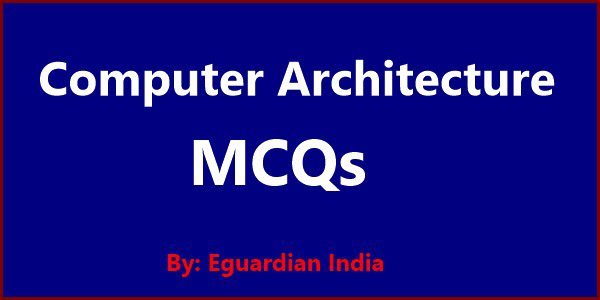Computer Architecture MCQs with answers pdf multiple choice questions for students who are preparing for academic and competitive exams.
These questions provide an in-depth understanding of different aspects of computer architecture, including memory management, processor design, input-output management, and more.
Computer Architecture MCQs with answers
1. ___ is used to reduce cache hit time.
A. Pseudo-associative caches
B. Avoiding address translation during cache indexing
C. Early restart and critical word first
D. Giving priority to read misses overwrites
Answer: (B)
2. What does drive D or E symbolize?
A. Floppy drive
B. Hard disk
C. Second floppy drive
D. CD-ROM drive
Answer: (D)
3. The beginning of the architecture of the Itanium processor took place at ___.
A. Intel
B. Microsoft
C. Hewlett-Packard
D. Dell
Answer: (C)
4. In the year 1834, Babbage attempted to build a digital computer, called ___.
A. IAS machine
B. Difference engine
C. Analytical engine
D. Pascaline
Answer: (C)
5. In pipelining, the CPU executes each instruction in a series of following stages: Instruction Fetching (IF) —–> Instruction Decoding (ID) —–> Instruction Execution (EX) —–>__ and Register Write back (WB).
A. Linear pipelines
B. Non-linear pipelines
C. Structural hazards
D. Memory access (MEM)
Answer: (D)
6. The core element of parallel processing is ___.
A. Data sequencing.
B. CPU’s
C. Instruction execution
D. Printer
Answer: (B)
7. Ease-of-use and extensive graphic capabilities are the important characteristics of ___.
A. Servers
B. Desktop computers
C. Minicomputers
D. Micro-computers
Answer: (B)
8. ___ is a memory-memory vector machine that fetches vectors directly from memory to load the pipelines as well as stores the pipeline outcomes directly to memory.
A. CCF Cyber 205
B. CCD Cyber 205
C. CDC Cyber 205
D. CFC Cyber 205
Answer: (C)
9. Fine-grain threading is considered as a ___ thread.
A. Instruction-level
B. Loop level
C. Task-level
D. Function-level
Answer: (A)
10. Define the mapping process.
A. It is a process of transforming data from main memory to cache memory.
B. It is a process that signifies the validity of the locality of reference.
C. It is a process, which translates the main memory address to the cache memory address.
D. It is a process of detecting a word in the cache.
Answer: (A)
11. ___ is the logical structure of a computer’s Random-Access Memory (RAM).
A. Memory addressing
B. Operation field
C. Address field
D. Addressing mode
Answer: (A)
12. ___ the pipeline solution is considered attractive due to its simplicity for hardware and software.
A. Instruction count – 0xFF01
B. Flush
C. Load-stall count – 0xFF02
D. Program counter
Answer: (B)
13. In dynamic scheduling, the hardware ___ the instruction execution to reduce stalling of the pipeline.
A. Rearranges
B. Bypasses
C. Forwards
D. Unhide
Answer: (A)
14. The ALU performs the indicated operation on the operands prepared in the prior cycle and store the result in the specified destination operand location.
A. Fetch instruction
B. Decode instruction
C. Execute instruction
D. Fetch operand
Answer: (C)
15. ___ states that “the performance improvement to be gained from using some faster mode of execution is limited by the fraction of the time the faster mode can be used.”
A. Principle of the locality
B. Hybrid technique
C. Variable-length technique
D. Amdahl’s Law
Answer: (D)
16. ___ is an operation that fetches the non-zero elements of a sparse vector from memory.
A. Strip mining
B. ETA-10
C. Scatter
D. Gather
Answer: (D)
17. ___ execution is the temporal behaviour of the N-client 1-server model where one client is served at any given moment.
A. Single data
B. Concurrent
C. Parallel
D. Multiple data
Answer: (B)
18. In which command, the interface responds by transmitting data?
A. Data input
B. Status
C. Data output
D. Control
Answer: (C)
19. Registers that are maintained by some of the processors for recording the condition of arithmetic, as well as logical operations, are called ___.
A. Condition code registers
B. Non-condition code registers
C. Re-locatable code
D. Branch registers
Answer: (A)
20. ___ mapping is used in cache organization which is the quickest and most supple organization.
A. set associative
B. Direct
C. Sequential
D. Associative
Answer: (D)
21. The high-level attributes of a computer’s architecture, such as the memory system, the memory integration, and the architecture of the internal processor or CPU, are components of the term ___.
A. Organisation
B. Hardware
C. Software
D. Instruction set
Answer: (A)
22. The smallest unit of memory that the CPU can read or write is ___.
A. Word
B. Mode
C. Cell
D. Field
Answer: (C)
23. In which of the following cases, any completing instruction may not be permitted to write its result?
A. One of the operands is the same as the result of the completing instruction
B. Existence of any instruction which has read its operand
C. Operands that do not have the same register as destination
D. If the scoreboard has not detected any WAR hazard
Answer: (A)
24. ___ is collecting the group of data elements distributed in memory and after that placing them in linear sequential register files.
A. Vectorisation
B. Pipelining
C. Memory
D. Vector register
Answer: (A)
25. The configuration, in which no difference between memory and I/O devices is seen by the CPU, is referred to as ___.
A. Memory unit
B. Memory-mapped I/O
C. Memory address register
D. Memory unit
Answer: (B)
26. ___ address of the operand calculated during the prior cycle is used to access memory.
A. Memory access completion cycle
B. Instruction decode fetch cycle
C. Instruction fetch cycle
D. Memory access fetch cycle
Answer: (A)
27. A normal CPU operates on ___.
A. Multiple scalars
B. Multiple vectors
C. Vector
D. One scalar at a time
Answer: (D)
28. How many distinct functional units are present in CDC6600?
A. 16
B. 7
C. 5
D. 4
Answer: (A)
29. The fourth generation of computers (1978-till date) was marked by the use of ___.
A. Integrated Circuits
B. Large-Scale Integrated (LSI) circuits
C. Transistors
D. Vacuum Tubes
Answer: (B)
30. ___ occurs when an instruction depends on the result of previous instruction in a way that is exposed by the overlapping of instructions in the pipeline.
A. Data hazards
B. Control hazards
C. Structural hazards
D. Hazard in the pipeline
Answer: (A)
31. In ___ each address field determines two address fields i.e. either a memory word or the processor register.
A. Zero-address instructions
B. Two-address instructions
C. One-address instructions
D. Three-address instructions
Answer: (B)
32. What was used to store a small number of bytes of data?
A. RAM
B. Disks
C. Punch cards
D. Tape drives
Answer: (C)
33. The scalar registers are also linked to the functional units with the help of the pair of ___.
A. Crossbars
B. Vertical bars
C. Horizontal bars
D. Straight bars
Answer: (A)
34. ___ must be able to deal with both register and memory operands as well as destinations.
A. CISC pipelines
B. RISC pipelines
C. Load/Store by-passing
D. Branch instructions
Answer: (A)
35. ___ design separates the testing for condition as well as branching. It is followed by Pentium which makes use of the flag register for recording the outcome of the test condition.
A. Test-and-jump
B. Condition code register
C. Set-then-jump
D. PC-relative
Answer: (C)
36. In ___ operation a vector moves from memory to vector register.
A. Integer operation
B. Logical operation
C. Load vector operation
D. Store vector operation
Answer: (C)
37. Which function can fetch and issue instructions from a queue or latch?
A. IF
B. DLX
C. ID
D. EX
Answer: (A)
38. ___ consists of a variety of expert instruction and may just not be frequently used in practical programs.
A. Complex instruction set computer
B. Reduced instruction set computer
C. Very long instruction word
D. Very short instruction word
Answer: (A)
39. The term RISC stands for ___.
A. Random Instruction Set Computing
B. Register Instruction Set Computing
C. Reduced Instruction Set Computing
D. Reduced Instruction Set Compiler
Answer: (D)
40. For using the ___ technique, the compiler should have the entire knowledge of the system and its timings.
A. Pre-fetching
B. Non-blocking writes
C. Multithreading
D. Application of cache memory
Answer: (A)
41. ___ in a dataflow graph represents data paths.
A. Nodes
B. Sticky tokens
C. Edges
D. Data links
Answer: (C)
42. CPA stands for ___.
A. Carry-processor adder
B. Carry-propagation adder
C. Complex-process application
D. Computer-propagation adder
Answer: (B)
43. Consider the design aspects of a CM5 system with 32 processors and state which of the below options is true?
A. Memory of 32 Gbyte
B. 128 data paths
C. 3.0 synchronisation time
D. Peak speed of 128
Answer: (B)
44. ___ units are generally floating-point units that are completely pipelined.
A. Scalar registers
B. Vector load and store unit
C. Vector functional unit
D. Control unit
Answer: (C)
45. Which is the simplest scheme to handle branches?
A. Freeze or Flush the pipeline
B. Assume each branch as not-taken
C. Predict-not-taken or predict-untaken scheme
D. Assume each branch as taken
Answer: (A)
46. It deals with the issue of selection of hardware components and interconnecting them to create computers that achieve specified functional, performance, and cost goals.
A. Von-Neumann Architecture
B. Computational Model
C. Execution Model
D. Computer Architecture
Answer: (D)
47. In this mode, the instruction specifies a register in the CPU that contains the address of the operand and not the operand itself.
A. Register Indirect Mode
B. Auto-increment or Auto-decrement Mode
C. Register Mode
D. Immediate Mode
Answer: (A)
48. Layout and ___ are the two aspects of branch processing.
A. Handling of unresolved conditional branches
B. Accessing the branch target path
C. Branch detection
D. Micro-architectural implementation
Answer: (D)
49. Which of the following storage devices require constant electricity?
A. Hard drive
B. Disks
C. Tape drive
D. RAM
Answer: (D)
50. ___ is used to reduce cache hit time.
A. Giving priority to read misses overwrites
B. Early restart and critical word first
C. Avoiding address translation during cache indexing
D. Pseudo-associative caches
Answer: (C)
51. The equation of average memory access time = Hit time + ___ x ___.
A. Miss rate, Miss penalty
B. Miss penalty, Cache size
C. Miss penalty, Hit time
D. Cache size, Miss penalty
Answer: (A)
52. 1. ___ is a register that temporarily stores the data that is to be written in the memory or the data received from the memory.
2. ___ identifies the address of memory location from where the data or instruction is to be accessed or where the data is to be stored.
A. Memory Address Register, Instruction Register
B. Memory Buffer Register, Memory Address Register
C. Memory Address Register, Memory Buffer Register
D. Instruction Register, Memory Address Register
Answer: (C)
53. 1. The ___ should be checked for correctness.
2. ___ means either store can bypass loads or vice versa, without violating the memory data dependencies.
A. Reorder buffer, Load, and store reordering
B. Processor consistency, Reorder buffer
C. Speculative loads, Load/Store bypassing
D. Memory consistency, LMD
Answer: (C)
54. 1. In the late 1970s, we observed the emergence of ___ that were high-performance computers for scientific computing.
2. In the 1960s, the ___ used to be the most prevalent one.
A. Main-frame computers, Microcomputers
B. Supercomputers, Main-frame computers
C. Microcomputers, Supercomputers
D. Processors, Microprocessors
Answer: (B)
55. Consider the following statements with respect to RAIDS:
1. BIP is an acronym for Block-interleaved parity and is equivalent to RAID 3.
2. Magnetic disks help provide information when the disk fails as the information is recorded in each sector that helps detect errors.
State True or False:
A. 1- False, 2- False
B. 1- True, 2- True
C. 1- False, 2- True
D. 1- True, 2- False
Answer: (C)
56. 1. In pipelining, two or more instructions that are independent of each other can overlap. This possibility of overlap is known as ___.
2. In the case of DLX (DLX is a RISC processor architecture) pipeline, the structural & data hazards are examined during the ___.
A. Instruction level parallelism, Instruction decode
B. Floating-point registers, Structural hazards
C. Structural hazards, Data hazard
D. Instruction decode, Instruction level parallelism
Answer: (A)
57. Consider the following statements with respect to MPP:
1. If a fault occurs during computation, the sequence of instructions following the last dump to local memory must be repeated after the replacement of the fault-containing column.
2. The processing elements are linked by a 2-dimension near-neighbor mesh and this gives an advantage of high bandwidth.
State True or False:
A. 1- False, 2- False
B. 1- True, 2- True
C. 1- False, 2- True
D. 1- True, 2- False
Answer: (C)
58. 1. A common foundation or paradigm that links the computer architect
2. The ___ operates by manipulating symbols on a tape.
A. Computational model, Turing machine architecture
B. Turing machine architecture, Computational Model
C. Von-Neumann architecture, Dataflow architecture
D. Turing machine architecture, Von-Neumann architecture
Answer: (A)
59. Consider the following statements with respect to data hazards:
1. In pipelining, the control hazards arise when the sequence of reading/writing accesses to operands.
2. Pipelining has a major effect on changing the relative timing of instructions by executing them at the same time. This leads to data and control hazards.
State True or False:
A. 1- True, 2- True
B. 1- False, 2- True
C. 1- True, 2- False
D. 1- False, 2- False
Answer: (B)
60. Consider the following statements with respect to instructions for control flow:
1. In a program control type of instruction, execution of the instruction may change the address value in the program counter and cause the flow of control to be altered.
2. Once a data transfer or data manipulation instruction is executed, control returns to the decode cycle with the program counter containing the address of the instruction next in sequence.
State True or False:
A. 1- True, 2- True
B. 1- False, 2- False
C. 1- False, 2- True
D. 1- True, 2- False
Answer: (D)
61. 1. ___ is the system with multiple CPUs, which are capable of independently executing different tasks in parallel.
2. In this category every processor and memory module has a similar access time.
A. Multiprocessor, UMA
B. UMA, Microprocessor
C. Microprocessor, Multiprocessor
D. UMA, NUMA
Answer: (A)
62. The Cray-1usually had a performance of about ___, but with up to three chains running, it could hit the highest point at ___.
A. 80 MFLOPS, 140 MFLOPS
B. 80 MFLOPS, 120 MFLOPS
C. 80 MFLOPS, 240 MFLOPS
D. 120 MFLOPS, 240 MFLOPS
Answer: (C)
63. Consider the below-mentioned statements with respect to virtual address mode.
1. In the virtual address mode, cache access efficiency is faster than the physical addressing mode.
2. In the virtual address mode, cache lookup is delayed.
State True or False:
A. 1- True, 2- False
B. 1- True, 2- True
C. 1- False, 2- False
D. 1- False, 2- True
Answer: (D)
64. 1. ___ executes only the instructions that are commonly used in programs and thus, makes the process simpler.
2. ___ consists of a variety of expert instructions and may just not be frequently used in practical programs.
A. Complex instruction set computer (CISC), Very long instruction word (VLIW)
B. Reduced instruction set computer (RISC), Complex instruction set computer (CISC)
C. Reduced instruction set computer (RISC), Very long instruction word (VLIW)
D. Very long instruction word (VLIW), Reduced instruction set computer (RISC)
Answer: (B)
65. Consider the below-mentioned statements with respect to the dataflow graph:
1. Dataflow graph is also called a flow dependency graph.
2. Dataflow graph is asynchronous as the execution of a node starts when matching data is available at a node’s input ports.
State True or False:
A. 1- True, 2- True
B. 1- True, 2- False
C. 1- False, 2- True
D. 1- False, 2- False
Answer: (C)
66. Consider the following statements with respect to the number of pipeline stages used to perform a given task:
1. Specification of the subtasks to be performed in only the first stage of the pipeline.
2. Layout of the stage sequence, i.e., whether the stages are used in a strictly sequential manner or some stages are recycled.
State True or False:
A. 1- True, 2- True
B. 1- True, 2- False
C. 1- False, 2- False
D. 1- False, 2- True
Answer: (D)
67. 1. ___ is a method that is basically utilized for handling the problems related to the branch.
2. ___ helps in instruction execution. It receives branch instructions and resolves the conditional branches as early as possible.
A. Branch processing, Intel IA-64 architecture
B. Branch prediction, Branch processing
C. Intel IA-64 architecture, RISC
D. PC register, Branch prediction
Answer: (B)
68. 1. ___ occur from resource conflicts when the hardware cannot support all possible combinations of instructions in simultaneous overlapped execution.
2. ___ occurs when an instruction depends on the result of previous instruction in a way that is exposed by the overlapping of instructions in the pipeline.
A. Structural hazards, Data hazards
B. Control hazards, Structural hazards
C. Cache miss, Hazard in the pipeline
D. Control hazards, Cache miss
Answer: (A)
69. Consider the following statements with respect to parallelism in pipelining:
1. When two or more instructions that are independent of each other, overlap, they are called Dynamic Scheduling.
2. Straight line parallelism is always greater than loop level parallelism.
State True or False:
A. 1- True, 2- True
B. 1- True, 2- False
C. 1- False, 2- False
D. 1- False, 2- True
Answer: (C)
70. Consider the following statements with respect to I/O performance measures:
1. Throughput is the average number of tasks completed by the server over a period of time.
2. The two most common measures of I/O performance, used currently, are throughput and response time.
State True or False:
A. 1- True, 2- True
B. 1- False, 2- False
C. 1- True, 2- False
D. 1- False, 2- True
Answer: (C)
71. Which statement holds true for RISC based CPU architecture?
A. It focuses on maximizing the number of instructions per cycle.
B. It typically has a larger and more complex instruction set.
C. It emphasizes optimizing hardware for fewer, simpler instructions.
D. It prioritizes compatibility with legacy software.
Answer: (C)It emphasizes optimizing hardware for fewer, simpler instructions.
Explanation: RISC (Reduced Instruction Set Computer) architecture is designed to streamline and simplify the instructions that a CPU can execute. By focusing on a smaller set of straightforward instructions, RISC architecture aims to optimize hardware design, enabling faster execution of instructions.
72. What is a key advantage of RISC-based CPU architecture?
A. High power consumption
B. Compatibility with a wide range of software
C. Complex and lengthy instruction sequences
D. Improved instruction execution speed
Answer: (D) Improved instruction execution speed
Explanation: RISC architecture’s emphasis on simpler instructions allows for faster execution, as each instruction can be executed in a single clock cycle. This can lead to enhanced performance and more efficient processing.
73. Which type of instruction format is commonly associated with RISC-based architecture?
A. Variable-length instructions
B. Highly specialized instructions
C. Long and complex instructions
D. Fixed-length instructions
Answer: (D) Fixed-length instructions
Explanation: RISC architectures often use fixed-length instruction formats. This simplicity in instruction length contributes to efficient decoding and execution, aligning with the philosophy of RISC design principles.
74. How does RISC-based architecture impact compiler complexity?
A. It increases compiler complexity due to extensive instructions.
B. It decreases compiler efficiency by requiring longer codes.
C. It simplifies compiler design due to uniform instruction format.
D. It has no influence on compiler development.
Answer: (C) It simplifies compiler design due to uniform instruction format.
Explanation: RISC architecture’s uniform and simplified instruction set makes compiler design more straightforward. The consistent format allows compilers to generate optimized code more efficiently.
Computer Memory MCQs
Question 1: What is computer memory?
A) The physical components of a computer
B) The ability of a computer to process data
C) A temporary storage area for data and instructions
D) The speed at which a computer operates
Answer: (C) A temporary storage area for data and instructions
Explanation: Computer memory refers to the temporary storage space where data, instructions, and programs are stored for processing. It plays a crucial role in facilitating the smooth execution of tasks by providing quick access to information.
Question 2: Which type of computer memory retains data even when the power is turned off?
A) ROM (Read-Only Memory)
B) RAM (Random Access Memory)
C) Cache Memory
D) Virtual Memory
Answer: (A) ROM (Read-Only Memory)
Explanation: ROM is a type of memory that contains permanent instructions or data that cannot be modified. It retains its content even when the computer is powered off, making it suitable for storing essential system information.
Question 3: Which memory type is used to temporarily store data that the CPU is actively using?
A) Hard Disk Drive (HDD)
B) Flash Drive
C) RAM (Random Access Memory)
D) Optical Disk
Answer: (C) RAM (Random Access Memory)
Explanation: RAM is a volatile memory type that provides fast and temporary storage for data and instructions that the CPU needs while actively processing tasks. It allows for quick read and write operations, contributing to overall system performance.
Question 4: What is the purpose of cache memory in a computer system?
A) To permanently store user files
B) To act as a secondary storage device
C) To temporarily store frequently accessed data
D) To manage network connections
Answer: (C) To temporarily store frequently accessed data
Explanation: Cache memory is a small and high-speed memory that stores frequently used data to reduce the time it takes for the CPU to access that data from the main memory. This helps improve the computer’s processing speed and efficiency.
Read More:
- Computer architecture and organization MCQs
- MCQs on Computer Architecture: Set-2
- Communication Skills MCQs: Set-1
- Grid Computing MCQs




Did a search on Google and found this page at no.1. Congratulations. Great post and keep it up